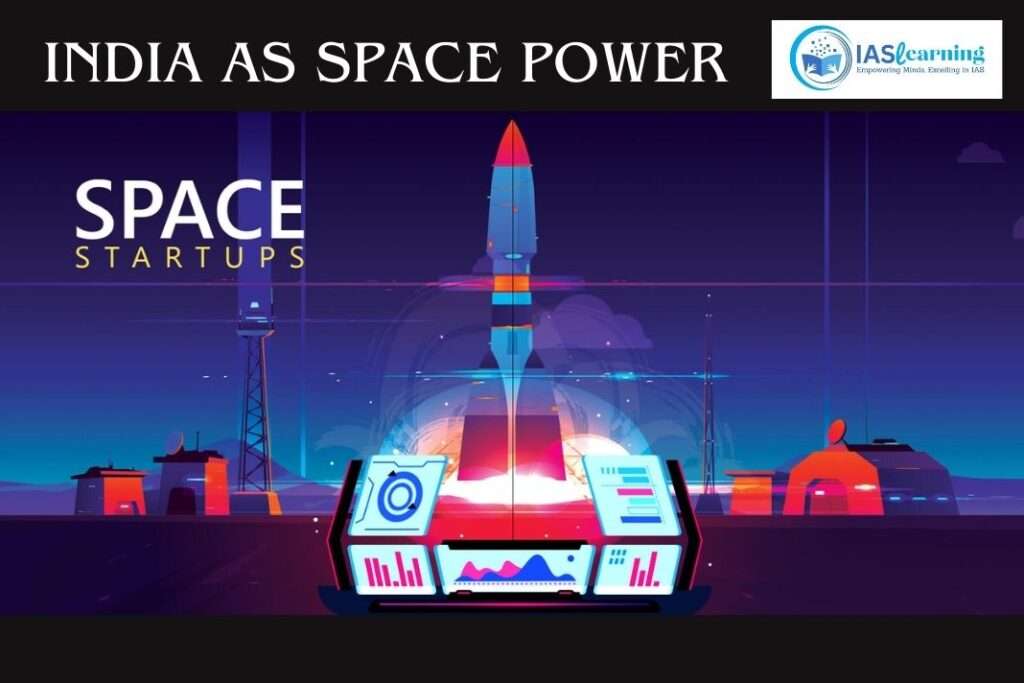INTRODUCTION INDIA AS A SPACE POWER
- Dr. Vikram Sarabhai’s goal for the Indian Space Program was that we should lead the world in the application of cutting-edge technologies for societal good.
- In 1962, the Indian National Committee for Space Research (INCOSPAR) was established.
- Following the 1963 launch of the first sounding rocket from Thumba Equatorial Rocket Launching Station, the space program officially began.
- INCOSPAR was replaced by the Indian Space Research Organization (ISRO), which was established in 1969.
- After the Space Commission and the Department of Space (DOS) were established in 1972, ISRO was placed under DOS.

Present Day Dedicated Clusters Of ISRO
- Vikram Sarabhai Space Centre (VSSC), Trivandrum became the hub for sounding rockets, solid propellants, etc.
- The cornerstone for payload development and related electronics is at Ahmedabad in the form of Space Applications Centre (SAC).
Journey of ISRO
Satellite
- On April 19, 1975, Aryabhata, India’s first satellite, was launched from a launch facility in the former Union Soviet. Later, the two experimental earth observation satellites Bhaskara-I and II gave the how to construct intricate, functional remote sensing satellites.
- The first experimental communication satellite launched by India was called APPLE- Ariane Passenger Pay Load Experiment. These Satellites were launched without charge, demonstrating India’s effective approach to international space collaboration.
- Two further noteworthy satellite communication tests included SITE (Satellite Instructional Television) and STEP- Satellite Telecommunication Experimental Project (1977–1979) and experiment (1975–1976). This created the route for the INSAT (Indian National Satellite) satellite series.

INDIA AS A SPACE POWER: Transport
- The Satellite Launch Vehicle-3 (SLV-3) project’s commissioning in the space transportation sector in the first indigenous experimental satellite launch vehicle appeared in the early 1970s.
- In July 1980, India’s SLV-3, a four-stage, all-solid launch vehicle, successfully lifted off. a small group of six nations that are able to launch satellites independently.
- Early in the 1980s, the ASLV- Augmented Satellite Launch Vehicle project represented the next stage in vehicle technology for launch.
- The Polar Satellite Launch Vehicle (PSLV) project began in the middle of the 1980s. In 1994, PSLV was successfully launched.
- The vehicle has established itself as an ISRO workhorse, launching national satellites on more than 50 successful missions in addition to foreign satellites.
- On February 15, 2017, the PSLV successfully launched 104 satellites, setting a new global record.
- The country set out on a very difficult journey to grasp the sophisticated cryogenic technology.
- An important milestone towards this was the commissioning of the Geosynchronous Satellite Launch Vehicle (GSLV) in the 1990s.
- The launch vehicle has four liquid strapons and three stages, including an upper cryogenic stage.
- Cryogenic technology involves the very low-temperature storage of liquid oxygen and hydrogen.
- With the locally developed Cryogenic Upper Stage’s successful qualification in the GSLV-D5 flight
- ISRO showed off its expertise with cryogenic rocket propulsion in January 2014.
- ISRO’s next-generation launch vehicle, which can carry a 4T payload in GTO, was introduced as GSLV-Mk III’s. In December 2014, the GSLV Mk III’s LVM3-X/CARE Mission, its first experimental suborbital flight, was launched.
- Chandrayaan-2 was successfully launched into Earth Parking Orbit by GSLV Mk III in July 2019.
INDIA AS A SPACE POWER: Satellite-based remote sensing
- INSAT-1B, the country of India’s first operational multipurpose satellite, was launched in 1983. It sparked a significant upheaval in the telecommunications, television, and weather forecasting industries in India.
- In 1988, IRS-1A, India’s first operational satellite, began photographing the planet. ISRO was active in the 1990s.
- India currently operates a series of cutting-edge remote sensing satellites. By improving broadband access, high throughput satellites (HTS) like GSAT11, GSAT-29, and GSAT-19 are assisting the Digital India program.

INDIA AS A SPACE POWER: Achievements
- India’s Chandrayaan-1, Mars Orbiter Mission, AstroSat, and Chandrayaan-2 space science programs have attracted the interest of everyone.
- With Chandrayaan-1, India became the Fourth nation after the United States,soviet unionand china to send a probe to the lunar surface.
- Chandrayaan-1 was largely acclaimed as a success after it successfully found water molecules on the surface of the moon.
- The PSLV-launched Mars Orbiter Spacecraft first made contact with Mars in September 2014.
- With this, ISRO has successfully launched a spacecraft into Mars orbit, making it the fourth space agency to do so.
- With the recent discovery of one of the earliest galaxies in extreme ultraviolet light, AstroSat recently made a significant advancement.
- Navigation with Indian Constellation (NavIC) was successfully established and operationalized by ISRO, which gives consumers incredibly precise Position, Navigation, and Time information.
- Additionally, ISRO offers satellite-based navigation using GPS Aided GEO Augmented Navigation (GAGAN).
- In 2018, the Indian government approved the Gaganyaan Program. The Space Flight of Humans to carry out the plan for the human space flight program, ISRO established the Human Space Flight Center (HSFC).
- The Gaganyaan project’s declared goal is to demonstrate human space travel capability to Low Earth Orbit (LEO) for a predetermined amount of time, followed by a safe return.
INDIA AS A SPACE POWER: Recent Changes
- The establishment of the Indian National Space Promotion and Authorization Center (IN-SPACe), allowing Non-Governmental Private Entities (NGPEs) to engage in space operations will free the subsequent wave of sectoral advancements.
- Giving department PSU NewSpace India Limited (NSIL) the authority to own the operational launch vehicles; and A new chapter in the country’s management of space activities is opened by the ISRO’s space assets.
- In addition, the current supply-based approach has been replaced with a demand-driven model, where NSIL will serve as a user requirements aggregator and simultaneously secure commitments
- INDIA AS A SPACE POWER :READ MOREhttps://qz.com/
- INDIA AS A SPACE POWER :DO FOLLOWhttps://iaslearning.in/




